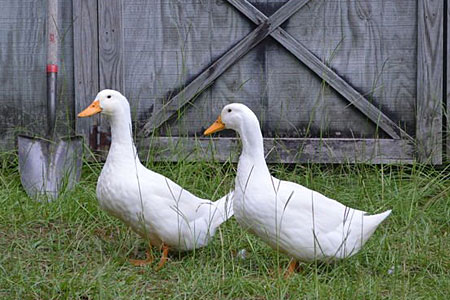
The White Pekin is the quintessential duck that most people think of when they hear the word “duck.” This big white duck derives from an ancient Chinese breed, the name of which translates as “ten-pound duck.”
The first Pekins in the United States arrived in the early 1870s, hatched in the Chinese city of Peking, which is now Beijing. The White Pekin duck appeared in the first edition of the American Standard of Perfection, published in 1874.
Physical Attributes
Both male and female White Pekins have white plumage set off by a bright yellow bill and feet. Males can be difficult to distinguish from females. Look for the male’s curly tail feathers, and listen for the female’s loud quack. Only the males have curly “sex” feathers. Only the females quack loudly.
Pekins reach 9 to 10 pounds at maturity. They shouldn’t be confused with Jumbo Pekins. The latter is a cross between two different Pekin strains, resulting in a duck that can weigh 13 pounds or more and can reach 90% of its mature weight in about 7 weeks. Jumbo Pekins are typically raised strictly for meat.
Breed Qualities
The White Pekin duck is a dual purpose egg and meat breed. The hens lay 140 to 175 white-shell eggs per year, starting at 4 to 5 months of age. The eggs are the largest laid by any duck breed. The hens rarely brood, and when they do they make unreliable mothers.
As meat birds, Pekins grow fast. With their white feathers, they pluck cleaner than darker breeds, since white pinfeathers don’t show as much. On the other hand, white plumage makes them more vulnerable to predators. Since Pekins are only fair foragers, anyway, they are not the best choice for free-range meat production.
The calm and docile White Pekin duck is too heavy to fly, adapts well to a variety of environments, and is easy to train. All together it makes a friendly and affectionate pet, as well as a terrific show bird.
Helpful Links
- Keeping Ducks for Eggs
- How to Keep Your Ducks Laying Well
- How the Eggs of Chickens, Turkeys, Ducks and Geese Compare
- How to Handle Duck Eggs for Eating
And that’s today’s news from the Cackle Coop.
Gail Damerow is the author of An Absolute Beginner’s Guide to Raising Backyard Ducks : Breeds, Feeding, Housing and Care, Eggs and Meat.

